
Ketchikan is a city in and the borough seat of the Ketchikan Gateway Borough of Alaska. It is the state's southeasternmost major settlement. Downtown Ketchikan is a National Historic Landmark District.

The Mary Island Light Station is a lighthouse located on the northeastern part of Mary Island in southeastern Alaska, United States.

The Tree Point Light is a lighthouse located adjacent to Revillagigedo Channel in Southeast Alaska, United States. It is located near the southernmost point of mainland Alaska.
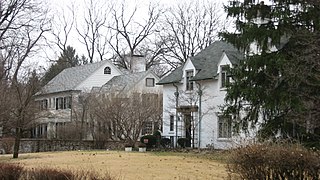
Golden Hill is an affluent and historic neighborhood overlooking the White River on the west side of Indianapolis's Center Township, in Marion County, Indiana. The district is bounded on the east by Clifton Street, which is west of Martin Luther King Jr. Boulevard ; on the west by the White River and the Central Canal; on the south by Thirty-sixth Street; and on the north by Woodstock Country Club, immediately south of Thirty-eighth Street. Golden Hill is noted for its collection of homes designed by several of the city's prominent architects. The estate homes reflect several styles of period revival architecture. The district is known as for its community planning and remains an exclusive enclave for the city's prominent families. Golden Hill was added to the National Register of Historic Places in 1991.

Old Colorado City, formerly Colorado City, was once a town, but it is now a neighborhood within the city of Colorado Springs, Colorado. Its commercial district was listed on the National Register of Historic Places in 1982. It was founded during the Pikes Peak Gold Rush of 1859 and was involved in the mining industry, both as a supply hub and as a gold ore processing center beginning in the 1890s. Residents of Colorado City worked at some of the 50 coal mines of the Colorado Springs area. It was briefly the capital of the Colorado Territory. For many years, Colorado Springs prohibited the use of alcohol within its border due to the lifestyle of Colorado City's opium dens, bordellos, and saloons. It is now a tourist area, with boutiques, art galleries, and restaurants.

Cape Nome Mining District Discovery Sites is a National Historic Landmark located in Nome, Alaska. It was named a National Historic Landmark in 1978. It is significant for its role in the history of gold mining in Alaska, in particular the Nome Gold Rush that began in 1899.

This is a list of the National Register of Historic Places listings in Ketchikan Gateway Borough, Alaska.
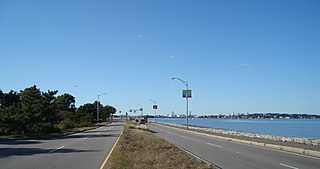
Quincy Shore Drive is a historic parkway in Quincy, Massachusetts. The road is one of a series of parkways built by predecessors of the Massachusetts Department of Conservation and Recreation, to provide access to parks and beaches in the Greater Boston area. Its development was proposed in 1893 by Charles Eliot, who promoted the development of many of the area's parks and parkways. Planning began in 1897, with land acquisition following around 1900. Construction of the 4-mile (6.4 km) road was begun in 1903 and completed in 1907.

The Ketchikan Federal Building is a courthouse of the United States District Court for the District of Alaska, located at 648 Mission Street in Ketchikan, Alaska. It was completed in 1938, and was listed on the National Register of Historic Places on April 28, 2006. The building's primary tenant is the United States Forest Service Tongass National Forest Supervisor's Office, which occupies space on the first, second, third, fourth and sixth floors. The fifth floor houses a courtroom and related support offices, while the first floor also houses an office of the United States Customs and Border Protection.
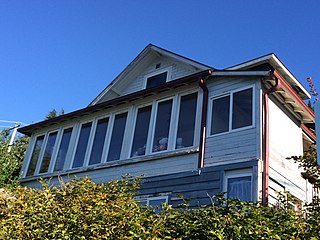
The Ketchikan Ranger House at 309 Gorge Street in Ketchikan, Alaska was built in 1916 in the residential Captain's Hill district of Ketchikan. Designed by USDA Forest Service in "Vernacular Victorian" style, it housed the U.S. Forest Service's district rangers until 1978. The 1+1⁄2-story frame house has remained essentially unaltered from its original construction. It was built for $650 to serve the first forest ranger for the state of Alaska.

The Walker-Broderick House, also known as the "Doc" Walker House, is a historic house at 541 Pine Street in Ketchikan, Alaska. It was listed on the National Register of Historic Places in 1982. The house is a single-story wood-frame structure, built in 1916-20 by local Ketchikan master builder Carl Foss. The house is an excellent local example of Craftsman styling, with broad eaves supported by large knee arches, large brick piers supporting the front porch, and a matching brick chimney on the side. Interior woodwork is well-preserved. The house was built for Norman "Doc" Walker, an early Ketchikan resident, pharmacist, and politician who served as mayor and in the Alaska Territorial Senate

The Burkhart-Dibrell House, also known as Monrean House, is a historic house at 500 Main Street in Ketchikan, Alaska. This three story wood-frame house was built in 1904 by H. Z. Burkart, the founder of Ketchikan Spruce Mills, and is the only significant surviving Queen Anne style house in Ketchikan. It occupies a prominent position at the head of Main Street, and has long been a local landmark. In 1916, the house was purchased by Captain Walter Dibrell, Superintendent of Lighthouses for all of Alaska. The house's most prominent feature is its turret with conical roof and gold spire.

The Gilmore Building, also known as the Gilmore Hotel, is a historic commercial building at 326 Front Street in Ketchikan, Alaska. It is a three-story masonry building located adjacent to Ketchikan City Hall, and was built in 1926-27 by P. J. Gilmore, Sr. to meet growing demand in the growing community for retail space and hotel rooms. The build is in the shape of a reversed L, whose base lies along Front Street, and includes three commercial storefronts. The upper floors are populated with hotel rooms.
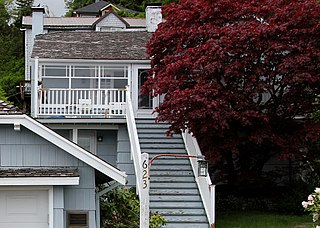
The Ziegler House, also known as the Ziegler/Pitcher House, is a historic house at 623 Grant Street in Ketchikan, Alaska. It is a two-story wood frame residence, set on a hillside. It is roughly rectangular in shape, with a hip roof with clipped-gable ends. The house was built as a relatively small structure in 1911, and underwent a significant expansion in 1922 to achieve its present appearance. The house has been the longtime home of members of the locally prominent Ziegler family, and was built by Adolph Holton Ziegler (1889-1970) who served as mayor of Ketchikan and in the territorial legislature. His son, Robert Holton Ziegler, became a prominent local lawyer, serving in the territorial and then state legislatures.

The Stedman–Thomas Historic District encompasses what was historically the southern portion of Ketchikan, Alaska. It extends along Stedman and Thomas Streets, from Ketchikan Creek in the north to East Street in the south, and includes a few properties on adjacent spur side streets. In the early days of the city, the area was a seasonal Native fishing camp just south of the creek, but the Alaskan gold rushes around the turn of the 20th century brought an influx of settlers to the area.
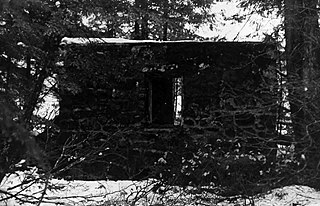
Storehouse No. 3 is one of four historic storehouses built by the United States Army along the Portland Canal on the west coast of North America. Built out of rubble stone in 1896, they were built at a time of tension with neighboring Canada over exact location of the international border in the area. The border location was resolved by arbitration in 1903, with two of the four warehouses falling in Canadian territory. None of the warehouses were apparently ever used. Storehouse No. 3 is located on Halibut Bay, on the northwest side of the Portland Canal. The storehouse was listed on the National Register of Historic Places in 1977.

The Star is a historic commercial building at 5 Creek Street in Ketchikan, Alaska, United States. It is the only one of a once-numerous collection of brothels that famously lined Creek Street to retain its historical integrity, and was one of the largest in the city.
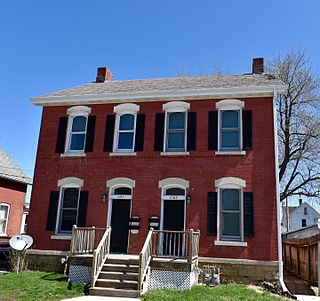
Washington Street and East 22nd Street Historic District is a nationally recognized historic district located in Dubuque, Iowa, United States. It was listed on the National Register of Historic Places in 2015. At the time of its nomination it consisted of 34 resources, which included 29 contributing buildings, and five non-contributing buildings. The focus of this district is a cluster of brick buildings around the intersection of Washington and East 22nd Streets on the north side of Dubuque. Its location west of the former Chicago Great Western Railway and the Chicago, Milwaukee, St. Paul and Pacific Railroad yards led to a large percentage of the residents here to be higher ranking railroad employees. The historic buildings are brick and frame houses, with the exception of one brick storefront/residence. Most of the houses are front or side gabled vernacular structures, and a few that are Italianate or Classical Revival. Couler Creek, which was located behind the houses on the east side of Washington Street, also affected the development of this area. There is no alley behind the houses on the east side of Washington. Flooding was also a major problem in this area until the creek was covered in a stone-arched sewer and continues to flow under ground.

The Downtown Ketchikan Historic District in Ketchikan, Alaska was listed on the National Register of Historic Places in 2017.

The Davenport Motor Row and Industrial Historic District is a nationally recognized historic district located on the eastern edge of downtown Davenport, Iowa, United States. It was listed on the National Register of Historic Places in 2019. At the time of its nomination it consisted of 28 resources, which included 21 contributing buildings, one contributing site, one contributing structure, and five non-contributing buildings. The area was previously a part of the notorious Bucktown, a district of saloons, beer gardens, brothels, billiard parlors, gambling establishments, and theaters. Davenport licensed prostitution in 1893, gambling in 1904, and failed to enforce Iowa prohibition laws during this period. A crusade against vice by Davenport's Catholic bishop, Henry Cosgrove, and reforms by state leaders led to the district's transformation in the early 20th century into a light industrial area. The city's automobile industry settled here beginning in the 1910s. They stayed until the mid-20th century when Interstate 80 was completed on the north side of the city and they moved to the suburban areas. U.S. Route 32 and its successor U.S. Route 6 passed through the district on East Second Street from 1926 to 1937. The Government Bridge (1896), which for years was the city's only bridge across the Mississippi River, is immediately adjacent to the district.






















